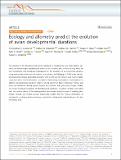Ecology and allometry predict the evolution of avian developmental durations
Abstract
The duration of the developmental period represents a fundamental axis of life-history variation, yet broad insights regarding the drivers of this diversity are currently lacking. Here, we test mechanistic and ecological explanations for the evolution of developmental duration using embryological data and information on incubation and fledging for 3096 avian species. Developmental phases associated primarily with growth are the longest and most variable, consistent with a role for allometric constraint in determining the duration of development. In addition, developmental durations retain a strong imprint of deep evolutionary history and body size differences among species explain less variation than previously thought. Finally, we reveal ecological correlates of developmental durations, including variables associated with the relative safety of the developmental environment and pressures of breeding phenology. Overall, our results provide broad-scale insight into the relative importance of mechanistic, ecological and evolutionary constraints in shaping the diversification of this key life-history trait.
Citation
Cooney , C R , Sheard , C E , Clark , A D , Healy , S D , Liker , A , Street , S E , Troisi , C A , Thomas , G H , Székely , T , Hemmings , N & Wright , A E 2020 , ' Ecology and allometry predict the evolution of avian developmental durations ' , Nature Communications , vol. 11 , 2383 . https://doi.org/10.1038/s41467-020-16257-x
Publication
Nature Communications
Status
Peer reviewed
ISSN
2041-1723Type
Journal article
Description
This work was funded by a Leverhulme Early Career Fellowship (ECF-2018-101) to C.R.C., a NKFIH (KH 130430) and a Hungarian Ministry of Human Capacities grant (20385-3/2018/FEKUSTRAT) to A.L., a Royal Society University Research Fellowship (URF\R\180006) and European Research Council grant (615709 Project ‘ToLERates’) to G.H.T., a Royal Society Wolfson Merit Award (WM170050, APEX APX\R1\191045), a Leverhulme Trust grant (RF/2/RFG/2005/0279, ID200660763) and a National Research, Development and Innovation Office of Hungary grant (ÉLVONAL KKP-126949, K-116310) to T.S., a Royal Society Dorothy Hodgkin Research Fellowship (DH160200) to N.H. and a NERC Independent Research Fellowship (NE/N013948/1) to A.E.W.Collections
Items in the St Andrews Research Repository are protected by copyright, with all rights reserved, unless otherwise indicated.

